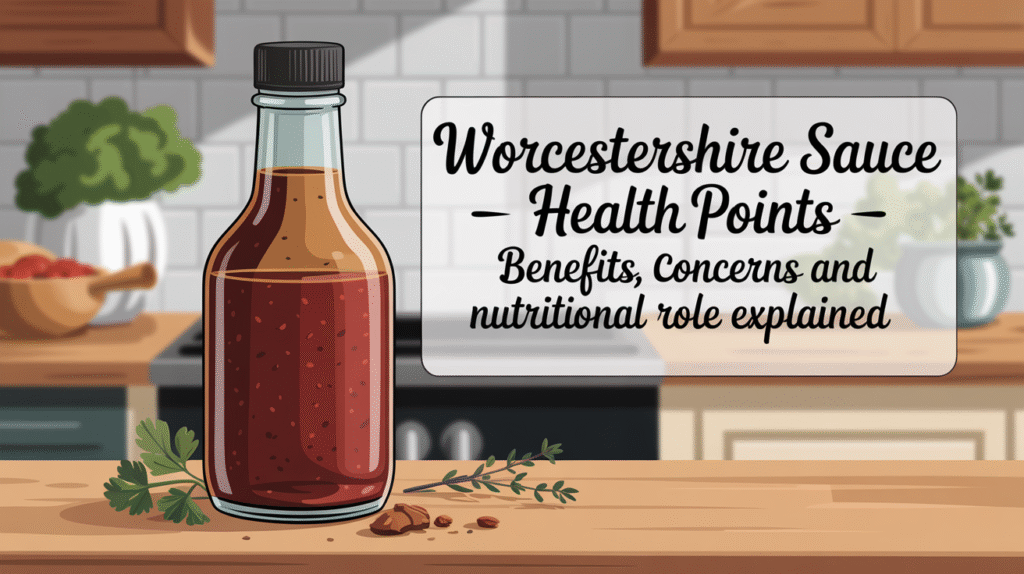Affiliate Disclosure: PantryBrands.co.uk is a participant in the Amazon.co.uk Associates Programme. As an Amazon Associate, we earn from qualifying purchases made through links on this site.
Worcestershire sauce offers a rich burst of flavour while being surprisingly low in calories and fat. Though it’s often used in small amounts, this savoury condiment contains ingredients that may offer certain health benefits—but also a few potential concerns depending on individual dietary needs.

Here’s a detailed look at the health points of Worcestershire sauce, from its nutritional makeup to the effects of its core ingredients and how it fits into a balanced diet.
Is Worcestershire Sauce Healthy?
Yes, Worcestershire sauce can be considered healthy when used in moderation. It is low in fat and calories, yet rich in flavour, making it a good option for enhancing meals without significantly impacting caloric intake.
Nutritional Overview
Most commercial Worcestershire sauces contain:
- Low calories – Roughly 5–10 calories per tablespoon
- Minimal fat – Typically less than 0.5 grams per serving
- Some sugar and salt – Around 1g of sugar and 65–200mg of sodium per teaspoon
- Micronutrients – Trace amounts of vitamins B6, B12, and iron due to anchovies and molasses
Because only small quantities are used per meal, Worcestershire sauce contributes little to total calorie intake but adds significant flavour.
Health Benefits of Worcestershire Sauce Ingredients
The individual components of Worcestershire sauce bring some interesting nutritional contributions.
Fermented Anchovies
Anchovies are a key ingredient and offer a modest amount of omega-3s and protein.
- May contribute to heart health in tiny amounts due to omega-3 fatty acids
- Contain vitamin B12, essential for energy and brain function
Vinegar and Tamarind
Both are acidic components that have been traditionally valued for digestion.
- Vinegar may support appetite regulation and glycaemic response
- Tamarind is rich in antioxidants and may have anti-inflammatory properties
Spices and Garlic
The warming spices and garlic used provide more than just taste.
- Garlic has been studied for its potential immune-boosting effects
- Clove and chilli extracts may have mild antimicrobial and antioxidant properties
Potential Dietary Concerns
While Worcestershire sauce is safe and beneficial for many, it’s important to be aware of specific dietary restrictions.
Sodium Content
Worcestershire sauce can be relatively high in salt, especially if consumed with other salty foods.
- High sodium intake may increase blood pressure in salt-sensitive individuals
- Check the label and choose low-sodium versions if available
Allergens and Sensitivities
Some people may need to avoid Worcestershire sauce due to specific ingredients.
- Anchovies make it unsuitable for those with fish allergies or vegans
- Contains gluten in some brands (due to malt vinegar or soy sauce)
Who Should Be Cautious?
Certain individuals should moderate their intake or check the label carefully before using Worcestershire sauce.
People with High Blood Pressure
Due to sodium content, those managing hypertension should be cautious.
- Consider using reduced-sodium alternatives
- Balance with other low-sodium ingredients
Vegans and Vegetarians
Traditional versions are not plant-based, though vegan alternatives are available.
- Look for certified vegan Worcestershire sauces
- Homemade versions can be tailored to suit dietary needs
Can It Be Part of a Healthy Diet?
Yes, Worcestershire sauce can support a healthy diet when used to enhance whole foods without relying on heavy sauces or creams.
How It Fits in Meal Planning
Here’s how you can incorporate Worcestershire sauce wisely:
- Use it as a marinade base for lean meats or tofu
- Add to stir-fries and soups instead of excessive salt or oil
- Enhance vegetables with a dash for extra depth
Portion Control
Because of its bold flavour, you only need small amounts.
- Limit to 1–2 teaspoons per serving
- Watch sodium intake across the rest of the meal
Comparisons with Other Sauces
Compared to some other popular condiments, Worcestershire sauce often stands out nutritionally.
Versus Soy Sauce
Worcestershire typically contains less sodium per tablespoon than soy sauce.
- Has a more complex flavour, requiring smaller portions
- Soy sauce may be higher in gluten unless labelled gluten-free
Versus Ketchup
Ketchup tends to have more sugar and calories per serving.
- Worcestershire has a stronger savoury profile and less sugar
- Better option for savoury depth without sweetness
FAQs About Worcestershire Sauce Health Points
Here are some questions and answers about the health aspects of Worcestershire sauce.
Is Worcestershire sauce good or bad for you?
In moderation, it is good. It’s low in calories and fat but high in flavour, making it a smart choice for enhancing meals without adding too many calories or fats. However, its sodium content can be high, so use it wisely.
Can people with high blood pressure eat Worcestershire sauce?
Yes, but with caution. Since it contains sodium, it should be consumed in small amounts. People managing high blood pressure should check for low-sodium versions.
Is Worcestershire sauce suitable for a weight-loss diet?
Yes. It can enhance the flavour of low-calorie meals without adding fat or significant calories. Its rich taste helps make healthy meals more satisfying.
Does Worcestershire sauce contain sugar?
Yes, though the amount is small—usually around 1g per teaspoon. Some sugar-free versions exist, especially in health-focused or keto-friendly brands.
Can Worcestershire sauce be considered vegan?
Traditional versions are not vegan because they contain anchovies. However, vegan Worcestershire sauces are widely available and made without animal products.
